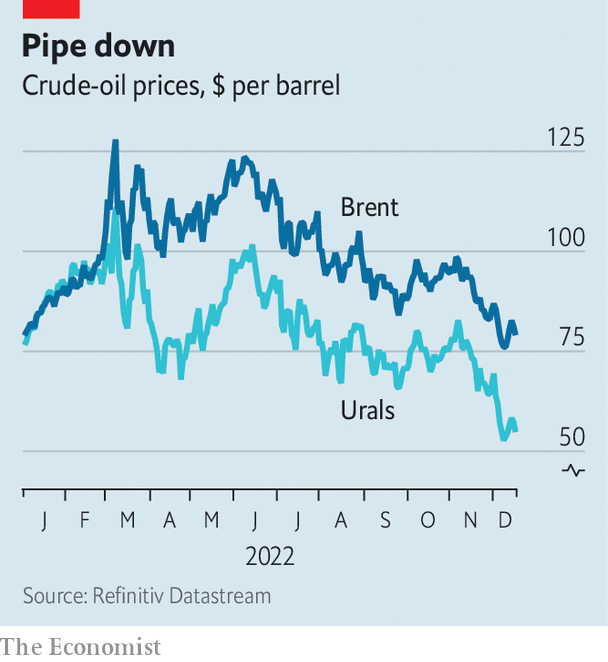The west has been trying to cut Russia’s oil-export revenues without causing global prices to spike since February. Both aims are seemingly being achieved at present. Russia exports as much oil as before its invasion of Ukraine, but Urals crude, the main grade it pumps, trades at a 37% discount to Brent, the global benchmark, meaning Moscow gets a poor deal. Brent, meanwhile, has fallen to an annual low of around $ 80 a barrel (see chart), meaning consumers face less of an energy crunch.

Little of this is down to Western efforts. On December 14th and 15th central banks in America, Britain and the eu announced interest-rate rises, and signalled more would come, sucking demand from the economy. China, reeling from soaring covid-19 cases, posted its worst factory and retail data in six months. Members of the Organisation for Petroleum Exporting Countries (opec) and its allies are producing nearly as much as before a cut to their collective target was announced in October, since most were already pumping below their quotas.
The West’s boycott of Urals, which accounts for 10-15% of the world’s crude supply, is probably bringing its price down a bit, as the grade undercuts others. An exemption to Europe’s ban on insurance for tankers carrying Russian oil, which applies to buyers that agree to pay a maximum of $ 60 per barrel, may be helping to prevent a supply shock. But neither measure is having a huge impact. If economic or market conditions change, prices could jump.
Moreover, financial punters seem to have had a greater hand than usual in depressing recent prices, which could portend a sudden upwards correction when the fundamentals of supply and demand kick back in. An industry source points to large “sell” orders being placed every day at 2pm London time in recent weeks. Events that should push up prices, such as the shutdown of the Keystone pipeline in America, one of the world’s largest, on December 9th, seem to have barely registered, notes Saad Rahim of Trafigura, a trading firm.
By the second quarter of 2023 there may be another oil shortage. Industrial users in Europe are switching from natural gas to cheaper gasoil. Consumption in India and the Middle East is proving more resilient than expected. China’s reopening will probably fuel an economic rebound after cases peak.
There are already signs that Europe’s insurance ban could end up proving more disruptive than expected. The iea, an official forecaster, reckons Russia will be forced to cut output by 1.6m b/d, to 9.6m b/d, by the second quarter. Loadings of a minor Russian grade called ESPO, which unlike Urals recently traded above $ 60, have nearly halved since December 5th, when the cap was introduced. Should rising oil demand push the price of Urals above $ 60, ship owners may well have second thoughts about carrying it, too.
Russia has threatened to cut supply to countries that abide by the cap, and growth elsewhere is projected to be sluggish. A deficit in global supply would eat into already slim global stocks, which remain close to five-year lows, causing prices to rise still further. All this means that the true test of the West’s oil-war tactics will probably arrive next year. ?
